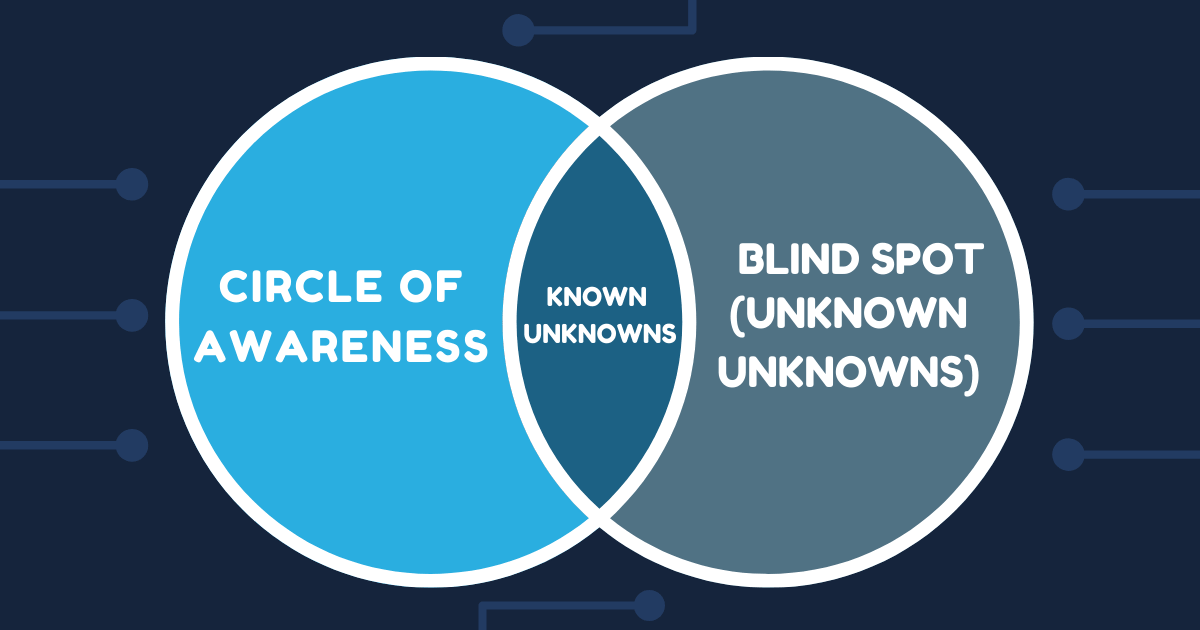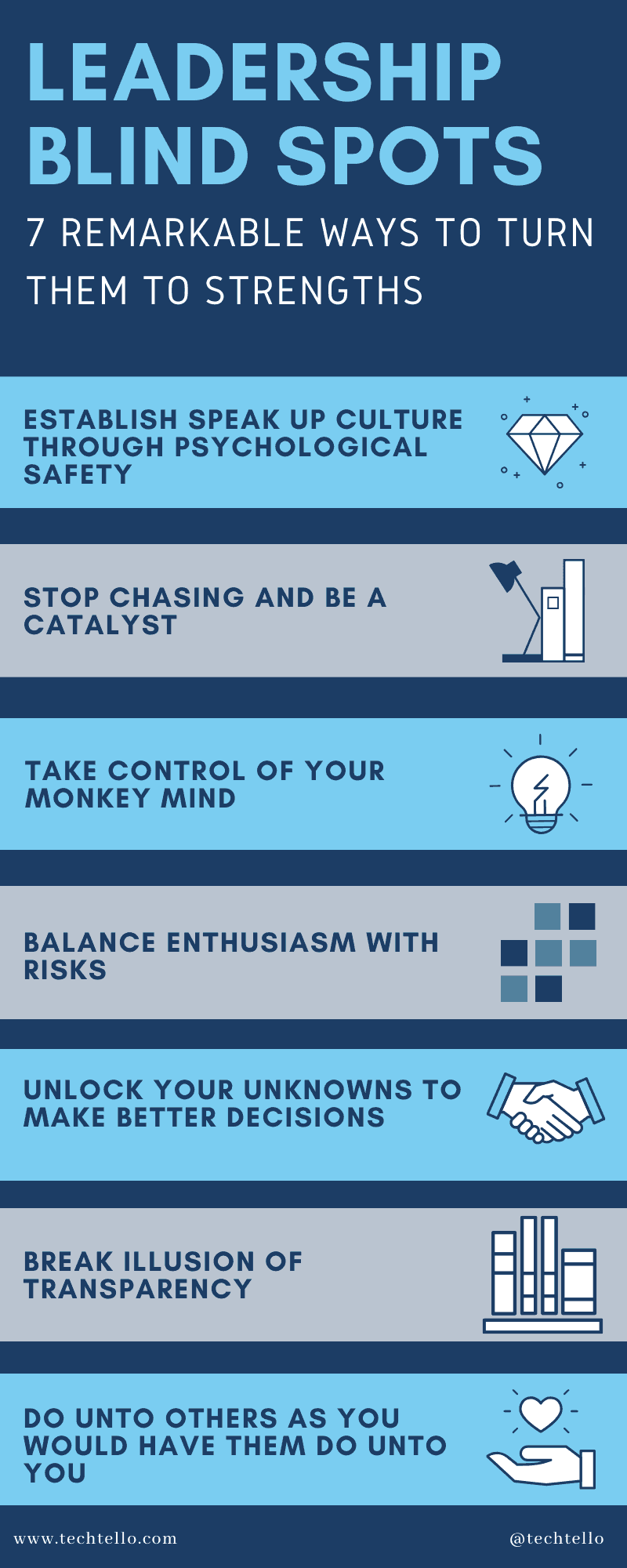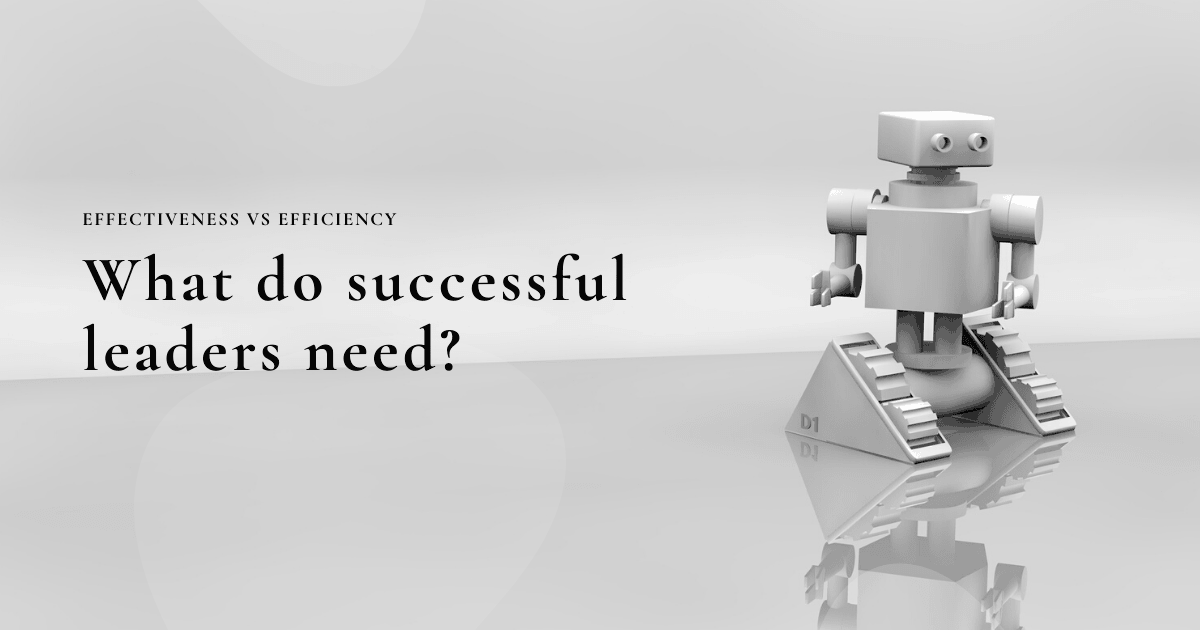Leadership Blind Spots: 7 Remarkable Ways To Turn Them To Strengths

We all have blind spots and insulating ourselves from this reality will not make it go away. As a leader of an organisation, it’s natural to not know everything. Some of these unknowns are in our circle of awareness (known unknowns) and then there are things that we don’t even know exist (unknown unknowns).
There are lurking gaps in how we see ourselves (or our actions) and how others perceive us leading to inadvertent blind spots. This is further exacerbated by our past beliefs, experiences, upbringing and many other psychological factors. Unless we take time to reconcile reality, these blind spots will perpetuate disconnect and dissonance with people.
In the fast paced world of technological advancements, employees are driven by their experience at work. We have the capacity to be remarkable and do things that establish trust and co-operation with the people we work with.
From The 7 Habits Of Highly Effective People by Stephen R. Covey
Leadership is communicating others’ worth and potential so clearly that they are inspired to see it in themselves
Yet, do we consciously think about blind spots and try to alleviate them?
To lead people effectively, it’s important to recognise these blind spots and take control of them. Much like other things that need practice and patience, acknowledging blind spots and flipping them around requires persistent effort.
To get started, ask yourself some of these questions:
- How do you behave with others?
- How do you make decisions?
- When and how do you share information?
- Are you someone who has an answer to everything (know-it-all) or you believe there’s more to learn?
- How connected do you feel to your people?
- Do people around you feel safe to share information?
- Do you believe you are not biased?
- How do you delegate work?
- Are you a strategic thinker who plans and provides direction to your team. Between effectiveness and efficiency, which one do you prioritise?
As you internally search for answers to some of these questions, the truth may not be congruent with your belief system and that can be uncomfortable at first. However, once you acknowledge it and learn to challenge your preconceived notions and assumptions about your team, you can discover a pathway to motivate employees to do their best work.
How to turn leadership blind spots to strengths
A leader has a large impact of their words, actions and body language on people around them. Leaders with authenticity, self awareness and willingness to learn and change can be a powerful force of a successful company or the ones with closed mindedness, sense of superiority, inflexible and uncooperative reason for its downfall.
Only those with the desire to learn about these blind spots can use the knowledge to their advantage and well being of the people around them. Being cognizant of our biases in how they shape our thinking and drive our actions can help us design strategies and apply right mental models to uncover and act on them.
From The Great Mental Models: General Thinking Concepts, by Shane Parrish
You can’t improve if you don’t know what you’re doing wrong
Blind Spot #1 – Establish speak up culture through psychological safety
Unspoken fear in organisations lead people to play safe. This blind spot can hold people back as they lack inspiration and support to surface things without fear of untoward consequences.
Organisations that succeed in the long run need leaders who can establish psychological safety with an environment of empathy to set the right tone and shape the culture and its people to be their most engaged self.
Leaders need to act as role models and establish vulnerability with their people first. Showing people that you don’t have all the answers and taking responsibility when things go wrong will have higher propensity to create a culture where people feel safe to make mistakes and learn from it.
Embracing constructive conflict and inputs at all levels can also drive innovation by creating a culture of trust where employees feel safe to bring out and debate new ideas.
Blind Spot #2 – Stop chasing and be a catalyst
Having clarity of purpose is foundational to a leadership role. It’s important for leaders to shift their priorities to provide more strategic leadership and direction, reflect on what they want and then determine how to get there.
For a leader to be effective, it’s important to do away with the “I am alone” mentality (the blind spot) and build team culture and mindset. They need to stop chasing goals and work on putting proper support structures in place to achieve them. A few things to establish trust that connects people to their purpose and enables discretionary effort in teams:
- Define goals and desired outcomes and review with the team
- Enable people to say no to multiple things to do the one right thing that will drive results for the company
- Listen actively and value others opinions
- Don’t impose, let people do their job. Use coaching as a powerful tool to help people own and reach their own conclusions.
- Review how work being done connects to the purpose and desired outcomes
Blind Spot #3 – Take control of your monkey mind
We all have a monkey mind and believe it or not, we are all biased. Our unconscious bias is our belief system, how we view the world, do what we do. It’s what enables preconceived notions and gives liberty to our brain to do short term thinking and apply shortcuts while making decisions.
For leaders, it’s imperative to realise and control the monkey mind that applies inherent biases at work and causes blind spots. When faced with difficult situations at work or while making decisions, leaders need to have a presence of mind to understand reality and put the monkey mind to rest. They can achieve this through:
- Do not avoid confrontation in trying to seek approval. It may be easy to make decisions that are validated by people around us, but those decisions may not be right.
- Do not look for people just like you while hiring or even in simple acts like grabbing a coffee. Go out of your comfort zone and establish a better working knowledge of the world by connecting with different people and appreciating their viewpoints.
- Learn to use multiple tools and frameworks and mental models through knowledge of multiple disciplines while determining solutions to problems. First-principles thinking and second order thinking are great examples of how to be clear headed and be more informed while making decisions.
Blind Spot #4 – Balance enthusiasm with risks
Giving people freedom to speak, think and execute can have some unforeseen consequences that require understanding of risks and developing measures to deal with it. Leaders need to establish a culture where freedom goes hand-in-hand with taking commitments seriously.
Too late and it may be irreparable. Closing these unintended gaps proactively requires planning for the future:
- Think about the unexpected events with your team. Ask questions – What can go wrong. If it goes wrong, what can we do about it?
- Lay out ground rules to enable effective cross team collaboration
- Enlighten your team about planning fallacy
- Establish KPIs from the beginning and reiterate to ensure goals are aligned
Daniel Kahneman from Thinking, Fast and Slow talks about this
The best we can do is a compromise: learn to recognise situations in which mistakes are likely and try harder to avoid significant mistakes when the stakes are high
Blind Spot #5 – Unlock your unknowns to make better decisions
Better decisions require a more inclusive process where others ideas and perspectives are taken into account. If you know what others think and have their support, your decision will not only have less errors, it will be more valued since the people executing it feel ownership in decision making.
Another aspect of better decision making is being aware of what other people think about us and how our actions impact them. There are gaps in what we think we are projecting and how others perceive it. As a leader, discovering this unknown requires learning how to create a feedback rich environment with the courage to seek feedback first.
Leaders should not rely only on managers. They should work with indirect reports to seek feedback and connect to the ground level truth. Ask the question – what’s your one blind spot that the person would like you to address?
First one-on-one meeting are a great way to connect and establish trust with people from the beginning and discover unknowns through follow up conversations.
Blind Spot #6 – Break Illusion of transparency
We believe that others understand our mental state in what we are feeling and how we are deciding. This illusion of transparency creates a blind spot where we do not care to explain our actions to others in an assumption that they understand. This blind spot is most prevalent and yet most unknown to leaders.
Breaking this illusion requires holding conversations with people to discuss and communicate strategic direction and priorities, align on goals and desired outcomes. It’s important to take a stand while ensuring people have the context to understand the rationale behind your decision.
In case of org level changes or any bad news, leaders get over protective and share less with the fear that their people will waste time worrying about details. They do not realise that these issues will surface out in other ways and less information may create more anxiety amongst people. While sharing such news with their people, leaders need to be transparent and set up multiple communication channels (group discussions, 1-1s) to discuss and seek feedback. This will not only avoid speculation, but establishes trust as the information flows directly from the top.
While dealing with people, being transparent also requires avoiding the safe path and having difficult conversations at work. Difficult conversations are an opportunity to do better and leaders should not abdicate this responsibility.
Blind Spot #7 – Do unto others as you would have them do unto you
This golden rule requires that you treat people with the same respect that you would like them to show towards you. People flourish in an environment of trust where they are treated with concern and kindness. Managing this blind spot requires being sensitive to your behaviour towards others.
While giving feedback, praise the person and criticise the behaviour (do not criticise the person). Saying that “you are bad while dealing with people” vs “I noticed that you sometimes get angry while speaking to…” makes a lot of difference. It’s important to be watchful of the tone and language to ensure the other person receives it well.
Dale Carnegie on how to set the motivation to do better in his book, How to Win Friends and Influence People:
Praise the slightest improvement and praise every improvement. Be hearty in your approbation and lavish in your praise.
Garner respect and use influence, not authority to drive decision making. Once people feel invested in the decision, they will put their best effort to drive results. You will also earn more respect by trusting them with it.
As a leader, your journey doesn’t end here. While there are many more blind spots, I have listed down some of the most important ones. Continue to experiment, put different ideas to use for challenges at the workplace. Through learning at work, you will find practical solutions that work for your specific environment and people.
Take dedicated time to study your decisions – how you made those decisions to how they turned out. Be aware of what’s happening around and be patient in making these changes. Acquiring true knowledge requires practice and experimentation.
What are your blind spots and how do you deal with them? Share with me in the comments below or write to me.































Great. Thanks, Vinita 🙂
Best Regards,
Tanmay